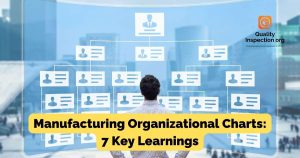What are manufacturing organizational charts and what are the key things that importers can learn from would-be suppliers’ org charts during the sourcing process? The tips given here will help you avoid bad suppliers and be aware of common red flags, especially in China.
Prefer listening to reading?
What are manufacturing organizational charts?
The org chart shows the lines of responsibility in a business from senior management downwards and it will be clear who is responsible for key functions like sales and marketing, production, HR, finances, IT, legal, etc. Each department will cascade down including who is responsible within that area of the business, such as COO, production manager, individual department managers, team leaders, workers, etc. Usually, a clear hierarchy will be evident, like the army or the church, and everyone should know who they report to. (02:03)
1. No Quality Dept.
A supplier that has no one responsible for quality and/or no staff doing inspections is probably only interested in pushing materials and products out of the door. This is particularly common in very small companies because in larger businesses that often claim to be ISO 9001 certified, the standard pushes them to clarify the structure of the business and include whoever is responsible for quality. (06:39)
2. Putting the production manager in charge of the quality team.
If a company has highly sophisticated management systems placing the quality department under the control of the production manager may make sense, but in most factories you’re likely to work with in China this is a red flag. Traditionally production managers will be driving on production to hit targets and will be blamed if there are delays. This is a conflict of interest with checking quality because if an inspector says there is a problem production has to be slowed down while something is fixed or reworked, they are likely to push back on this decision and will want to ship finished goods even if they have defects rather than unpacking them all and checking them. They might agree to pay more attention moving forward, but that doesn’t address the problem with the goods that have been made. (10:26)
3. Putting the production manager in charge of the planning department.
The production department is chiefly measured on labor productivity and the planning team will monitor the efficiency so resources can be managed and planned for future weeks and orders. Again, if a production manager is in charge of the team that is monitoring the efficiency of their production lines, it’s too easy to dilute standards in order to improve efficiency statistics and ‘look better.’ With a good ERP system in place, this is not such a problem as information can’t be manipulated as easily. (14:44)
4. No planning dept. in place.
A supplier that does not control planning might be an issue for you and could be problematic when it comes to getting your products out on time and sticking to an agreed production plan. Understanding how the supplier plans is good for benchmarking if they are reliable and well organised. They are also less likely to drop bad news on you at the last minute, because they will see ahead that, say, a container is going to be shipped out late and can provide advance warning and reasons why. If they are forever firefighting with supplier issues, machine breakdowns, etc, you’re dealing with an unstable supplier that probably can’t plan ahead anyway. (17:45)
5. No team of manufacturing engineers.
Manufacturing engineers (also known as process/industrial engineers) don’t work on product design and development but focus on systems and processes. If a manufacturer doesn’t have these engineers on staff, who plans for production to run smoothly with line balancing and who follows up on manufacturing issues like bottlenecks and puts them right? Again, if this is the remit of the production manager, they perhaps have different priorities. Without them, a manufacturer is likely to be very reactive, constantly firefighting, and unstable in terms of quality issues, cost rises, and delays which are the hallmarks of bad manufacturing processes. (20:35)
6. No dedicated HR department or the HR staff are at a junior level.
All but the smallest businesses need a dedicated HR manager or department. The HR department has 2 roles:
- Hiring talent and fostering the company’s culture.
- Compliance with employment laws and conditions.
Therefore, if your supplier doesn’t have HR staff, they could be a risk to you of being a link in your supply chain where social compliance is lacking and can affect your company’s reputation if it’s found that they flout labor laws, use child labor, etc.
If the HR staff are fairly junior employees with little authority, they’re likely to be more clerical only and don’t have a say in who is hired and if they fit into a cohesive company culture. This can lead to the wrong kinds of staff being hired who soon leave for one reason or another. This leads to instability which, again, has a knock-on effect on you the customer in terms of quality, delays, costs, etc. (24:16)
7. Job titles are unclear on the manufacturing organizational charts and sometimes inappropriate for the person.
If the org chart is confusing to you, it’s confusing for people working at the company. This can lead to misunderstandings about who is in charge of what. Also, some staff occasionally have inflated job titles that are not appropriate for their actual work. For example, in China, the GM’s assistant is sometimes known as the ‘Vice GM.’ But if you question this person about their authority and responsibilities, it turns out that they really are simply an assistant and cannot make decisions if the GM is away. (27:08)

